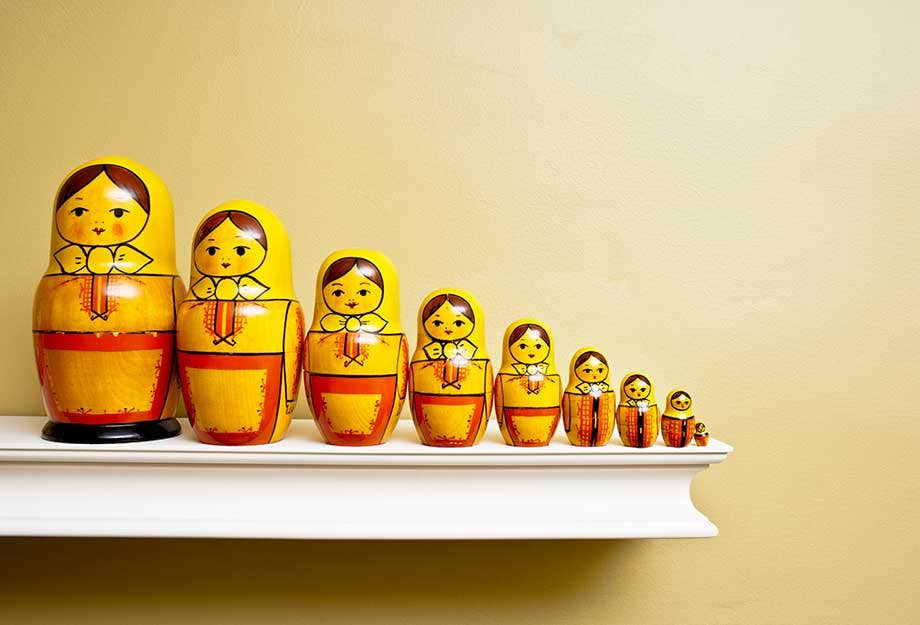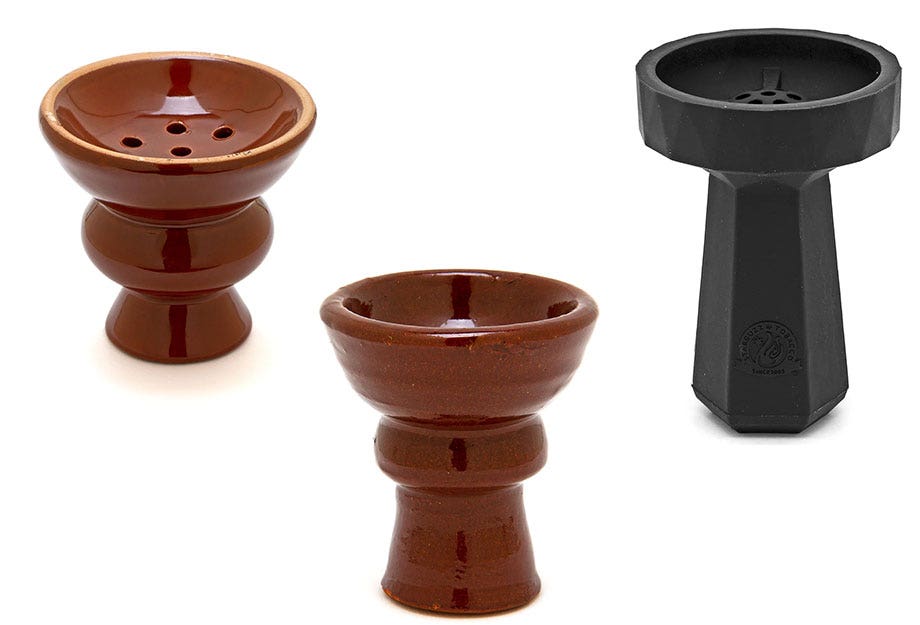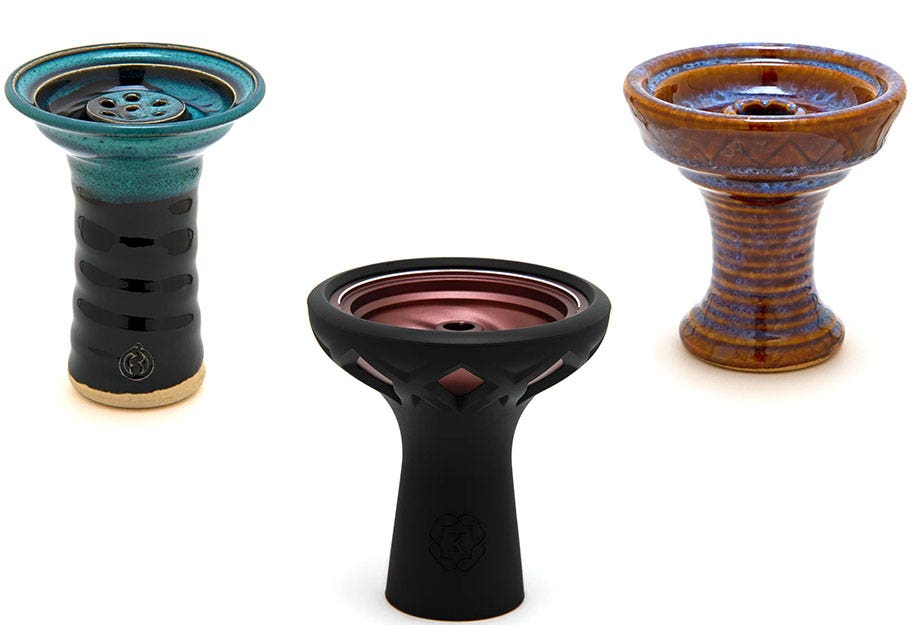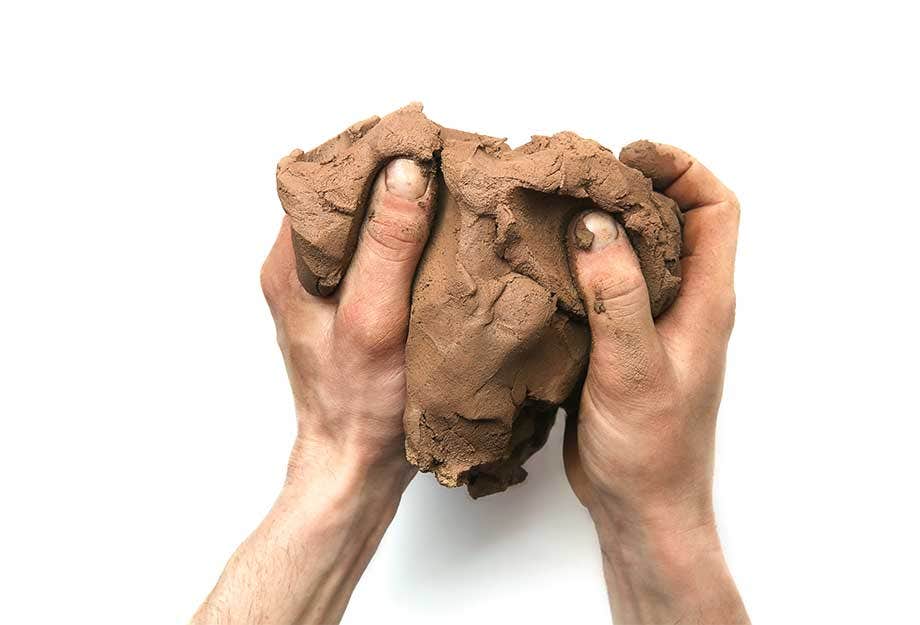
The Ultimate Guide to Types of Hookah Bowls
The world of hookah accessories is vast and offers shisha smokers a colossal variety of hoses, heat managers, bases, and yes, even hookah bowls! It can certainly be overwhelming to see the sheer amount of bowls available, especially if you’re new to hookah smoking or owning your own home setup, however, understanding the different types of hookah bowls and the materials they’re made from will help you find the best hookah bowl for thick clouds and smooth flavor.
In this comprehensive guide to hookah bowls, we’ll take you on a deep dive into allllll the different bowls we carry here at Hookah-Shisha, the differences between them, and which bowl might be best for you.
New to hookah? Unsure of what a particular word or phrase means? Check out our hookah glossary for a complete rundown of all the most common lingo used when talking hookah.
What is a Hookah Bowl?
A hookah bowl is a device or “dish” that usually sits at the very top of a hookah (though this can vary) and physically holds the shisha flavor or hookah tobacco when smoking. The flavored tobacco is packed inside the hookah bowl and is then covered with either aluminum foil or a heat management device (but more on that later).
Once the bowl is covered with foil and air holes have been poked, hookah charcoal is placed directly on top of the bowl. These coals heat up the bowl and the flavored tobacco inside, creating the thick, flavorful smoke that then gets pulled through the hookah with each inhale.
Types of Hookah Bowls
Now that we’ve gone over the basic concept of what a hookah bowl is and what it is used for, let’s dive into the different types of hookah bowls on the market today and their differences!
Traditional Bowls
Traditional bowls, also referred to as “Egyptian” hookah bowls, are some of the most commonly used hookah bowls in the world. This is due to the fact that they 1) come free with most hookahs and 2) they’re inexpensive and easy to replace. For these reasons alone, traditional bowls can be found in 90 percent of hookah lounges.
They are most notably characterized by having several small holes in the bottom of the bowl “dish” that shisha tobacco is packed on top of. They are most commonly made of clay, however, can be made from other materials like glass or silicone.
While this design provides consistent smoke sessions and is recommended for beginners, the flavoring and juices from more modern, juicy shisha tobacco have a tendency to drip down and out of the hookah bowl, down the hookah, and into the base. This can cause reduced flavor and session longevity.
For this reason, these hookah bowls work great with drier, more traditional shisha brands like Al Fakher or Nu Tobacco. These brands do not contain as much juice as many modern shisha brands and will be less likely to leak out of a traditional hookah bowl.
Phunnel and Vortex Bowls
Next in the progression of hookah bowls will be both vortex and phunnel bowls! These accessories feature an upgraded, modern design as compared to traditional bowls which typically leads to a large improvement in the overall performance of a hookah session.
Phunnel and vortex hookah bowls feature a raised center “spire” in the middle of the bowl dish rather than the concave empty dish of traditional bowls. This center spire contains airflow holes that sit above the shisha tobacco rather than below it. This design helps keep the flavoring from shisha tobacco from dripping into the hookah (like with a traditional design) and helps ensure better-tasting, longer-lasting flavor from the shisha.
While phunnel and vortex bowls follow very similar design concepts (like the raised spire), there are a couple of key differences. Vortex bowls have 3-4 small holes through the side of the raised spire while phunnel bowls have one large hole in the very top of the spire. Because of the hole placements and sizes, vortex bowls have slightly more restricted airflow while phunnel bowls typically have more open airflow.
Phunnel and vortex hookah bowls can comfortably be used with any type of hookah tobacco whether it be a drier, traditional shisha or a more modern, juicier shisha.
HMD-Compatible Bowls
The invention of heat management devices (HMDs) has drastically changed the way people smoke hookah over the last 5-10 years, and has even led to the creation of an entirely new category of hookah bowl!
A heat management device is a hookah accessory that was created to replace aluminum foil on bowls and provide cleaner flavor when smoking. Their unique design created a need for a special kind of hookah bowl with certain specifications that holds these devices firmly and securely. This is where HMD-compatible hookah bowls come into play!
HMD-compatible hookah bowls feature an interior “lip” in which an HMD like the Kaloud Lotus Plus can sit securely on the bowl with a perfect fit. These “lipped” bowls can feature a traditional, phunnel, or vortex-style dish design (see above). An HMD-compatible hookah bowl is not explicitly required when using a heat management device (in most cases), however, they will give you the most pleasant, hassle-free smoking experience when using an HMD since they are specifically made for that purpose.
Want to learn more about HMDs? Check out our in-depth blog on heat management devices and how they can improve your smoke sessions.
Hookah Bowl Materials
Now that you’re familiar with the different types of bowls, let’s talk about all the different materials that a hookah bowl can be made out of as well as their pros and cons.
Clay
Clay is one of the most common materials used when making hookah bowls due to its ability to be formed into any shape, its exceptional heat transfer properties, and of course, its generally low cost as a raw material. Most clay bowls are individually handmade by skilled artisans and may result in slight imperfections and minor size differences from bowl to bowl.
Clay hookah bowls are able to withstand the high heat of hookah charcoal and evenly distribute this heat throughout the shisha tobacco. This results in a more evenly cooked bowl of shisha. They can also come in glazed and unglazed varieties! Glazed clay hookah bowls are best when smoking a variety of shisha flavors as the glaze helps prevent flavor juices from being absorbed into the porous clay. Unglazed clay bowls are perfect for smoking a singular flavor as the juices will absorb into the clay and get stronger over time.
You can find an absolutely massive variety of clay hookah bowls on the market in a ton of different designs including traditional, phunnel, vortex, and HMD-compatible bowls.
Pros:
- Huge variety of designs
- Even heat transfer to your shisha
- Easy to find and widely available
- Compatible with a high number of hookahs
Cons:
- Fragile to physical damage and drastic temperature changes
Ceramic
Ceramic, while technically a derivative of clay, is another common material used when making hookah bowls. They are often thinner and more lightweight than regular clay bowls, however, are typically not as expensive due to their ability to be more easily mass-produced.
Much like clay bowls, ceramic hookah bowls can be made into a wide variety of designs and are compatible with a ton of hookahs, however, their thinner construction can feel “hollow” and less durable than their clay counterparts, and do not transfer heat to the shisha as evenly. Despite this, many ceramic hookah bowls still provide fantastic smoke sessions and their inexpensive price point makes them a great entry-level upgrade for those just starting out with their own hookah setup.
Pros:
- Wide variety of designs
- Inexpensive
- Compatible with a large number of hookahs
Cons:
- Fragile to physical damage and drastic temperature changes
- Less even heat distribution
- Less durable than standard clay
Glass
Glass is one of the less common materials used when making hookah bowls due to its fragility and intensive manufacturing process, however, it provides a unique set of benefits when it comes to shisha smoking. Glass hookah bowls do not absorb ANY flavor from shisha, and therefore provide a clean, accurate taste, and can also feature unique glasswork that helps your hookah stand out.
That being said, glass is not as proficient at transferring heat as compared to something like a clay bowl and is more susceptible to temperature changes. This can cause “hot spots” throughout your bowl and can unevenly cook, or even burn, your shisha, so you may have to pay a little extra attention to your charcoal management when using a glass bowl.
Lastly, some glass hookah bowls - like the ones included with Lavoo hookahs - are designed specifically for all-glass hookahs using glass-on-glass connections. These bowls are not typically compatible with most hookahs outside the ones they were designed for and can be hard to find if you need a replacement.
Nowadays, glass is often used alongside silicone to allow for more durability and increased compatibility across a variety of hookahs, such as with the Kaloud Vitria II bowl or Pharaohs Flo hookah bowl, but more on that later!
Pros:
- Unique designs
- Does not absorb flavoring
- Allows for clean tasting smoke
Cons:
- Less even heat transfer
- Susceptible to extreme temperature changes which can lead to cracking
- Extremely fragile (I mean it’s glass, of course it’s fragile)
Silicone
Silicone is a rubbery substance that is a relative newcomer to the world of hookah bowls and provides a whole host of unique benefits. For one, silicone hookah bowls are entirely shatterproof - with the exception of the silicone-glass hybrid bowls - and make great accessories for any precarious situation such as a party or traveling (or if you’re just clumsy like we can be).
In addition, silicone is a poor conductor of heat allowing it to be handled with minimal cooldown time and without the worry of burning your fingers - a great benefit when hot coals are involved. However, this also means that heat will not be transferred as evenly throughout the bowl resulting in a less evenly cooked shisha. Silicone also absorbs flavors more easily, resulting in a bowl that might become “stained” or “ghosted” with past flavors.
Some bowls - such as the Kaloud Vitria hookah bowls - use a combination of silicone and either metal or glass to improve the transfer of heat to the shisha while reducing the amount of flavor ghosting in the bowl, all while maintaining the durable qualities of silicone.
Lastly, the flexible properties of silicone make these bowls compatible with any hookah that features a traditional, “inside-fitting” bowl port! What’s even better is that the silicone neck of the bowl firmly grips the outside of the bowl port creating a perfectly airtight seal without the need for a pesky rubber bowl grommet! Worrying about loose or missing grommets is a thing of the past with silicone hookah bowls.
Pros:
- Shatterproof
- Heat-resistant
- Compatible with any hookah that features an inside-fitting bowl port
- Does not require a rubber bowl grommet
Cons:
- Prone to “flavor ghosting”,
- Less even heat transfer to the shisha
Aluminum
Aluminum is another less common material used when making hookah bowls, however, it has gained popularity in recent years and aluminum hookah bowls are starting to become more prevalent. Aluminum metal is extremely efficient when it comes to heat transfer, often heats up much more rapidly, and reaches a much higher temperature than most other types of hookah bowls.
Depending on how you prefer to smoke hookah, the heating capabilities of aluminum can be both a blessing and a curse. For one, your shisha will heat up much faster and will be cooked evenly from all sides of the bowl. On the other hand, the metal itself will get extremely hot and can run the risk of burning your hookah tobacco (and even you, if you’re not careful) and shortening your smoke session.
Note: Always exercise caution when handling an aluminum hookah bowl. Charcoal gets extremely hot and so does the metal, so touching the bowl before allowing it to properly cool down can quickly cause a burn. Always allow your aluminum or metal hookah bowl to cool down before handling.
Many “cloud chasers” - people whose entire goal is to get the most smoke possible - like aluminum hookah bowls because they have the capability of producing some extremely thick clouds of smoke, albeit for a shorter than average amount of time.
Aluminum hookah bowls are practically indestructible as well. You won’t have to worry if you drop it off a counter, onto your garage floor, or anything that may damage a more fragile bowl. Depending on the bowl and what it falls on, you may see some light scratches or scuffs in the bowl finish, but nothing that would prevent it from being used or providing a fantastic smoke session.
Pros:
- Extremely efficient heat transfer
- Practically indestructible
- Fast start-up time
- Can produce majorly thick clouds
Cons:
- Can get extremely hot
- Risks burning the shisha flavor
How Much Does a Hookah Bowl Cost?

With so many types of hookah bowls on the market today, there is naturally a wide range of prices as well! The final cost of a hookah bowl depends on a number of factors including the type of material, manufacturing technique, overall level of quality, and more. Some hookah bowls - such as the classic brown Egyptian hookah bowl - sell for as little as $1.99 USD while some premium, small-batch hookah bowls can sell for over $100 USD!
On average, you can expect to pay around $15-$30 USD for a hookah bowl depending on the brand, size, material, and more.
Does the Size of a Hookah Bowl Matter?

Ahh, the age-old question: “Does size matter?” When it comes to hookah bowls, yes! Size matters! The size of the bowl can determine which hookahs it is compatible with, how much shisha tobacco you use, the length of your smoke session, if you can use a heat management device, and even how many pieces of charcoal you need to use!
As a general rule, if you’re looking for shorter smoke sessions, we recommend using a smaller hookah bowl like the HookahJohn 80 Feet Espana bowl. If you’re interested in longer-lasting smoke sessions, a larger bowl like the Shisha House Bishop bowl or the Tangiers Medium phunnel bowl are fantastic options.
For a more in-depth look at how bowl size, bowl type, and more can affect the length of your smoke sessions, check out our blog on how long a hookah lasts.
Are Hookah Bowls Universal?
No, hookah bowls are not universal. A certain size or style of bowl may not be compatible with particular models of hookahs. For example, Lavoo glass hookahs come included with a glass hookah bowl that is not compatible with most traditional styles of hookahs, and most hookah bowls are not compatible with Lavoo hookahs without the use of an adapter.
To find out if your hookah is compatible with a certain style of hookah bowl, check out the bowl’s (or hookah’s) description or reach out to our friendly customer service team for answers to all your compatibility questions.
Which Hookah Bowl is the Best?
Which hookah bowl is best entirely depends on your hookah, your chosen shisha tobacco, your smoking preferences, and more, so the “best” choice is not always the same. For example, if you enjoy smoking modern, blonde-leaf tobacco that is quite juicy, a phunnel hookah bowl will likely be best. But if you prefer drier, more traditional tobacco brands, a traditional or Egyptian style hookah bowl may give you the quality of session you’re looking for.
The trick to choosing the best hookah bowl is considering what you look for out of a perfect smoke session, knowing and understanding the differences between the different types and materials, and recognizing their strengths and weaknesses. This allows you to choose the best hookah bowl for any situation and create a great-tasting smoke session every time.
If you’ve made it this far, congratulations, and thanks for reading! We know that this was a long one, so we appreciate you sticking in there. If you read this whole blog, you should now be an expert on the different types of hookah bowls, the differences between materials, and know how to find the best hookah bowl for you!
As always, if you have any additional questions or want to talk more about hookah bowls, reach out to our friendly customer service team and we’ll be more than happy to help you with all things hookah!
Happy smoking!
<3 Two Puff Tony
Categories
Month List





